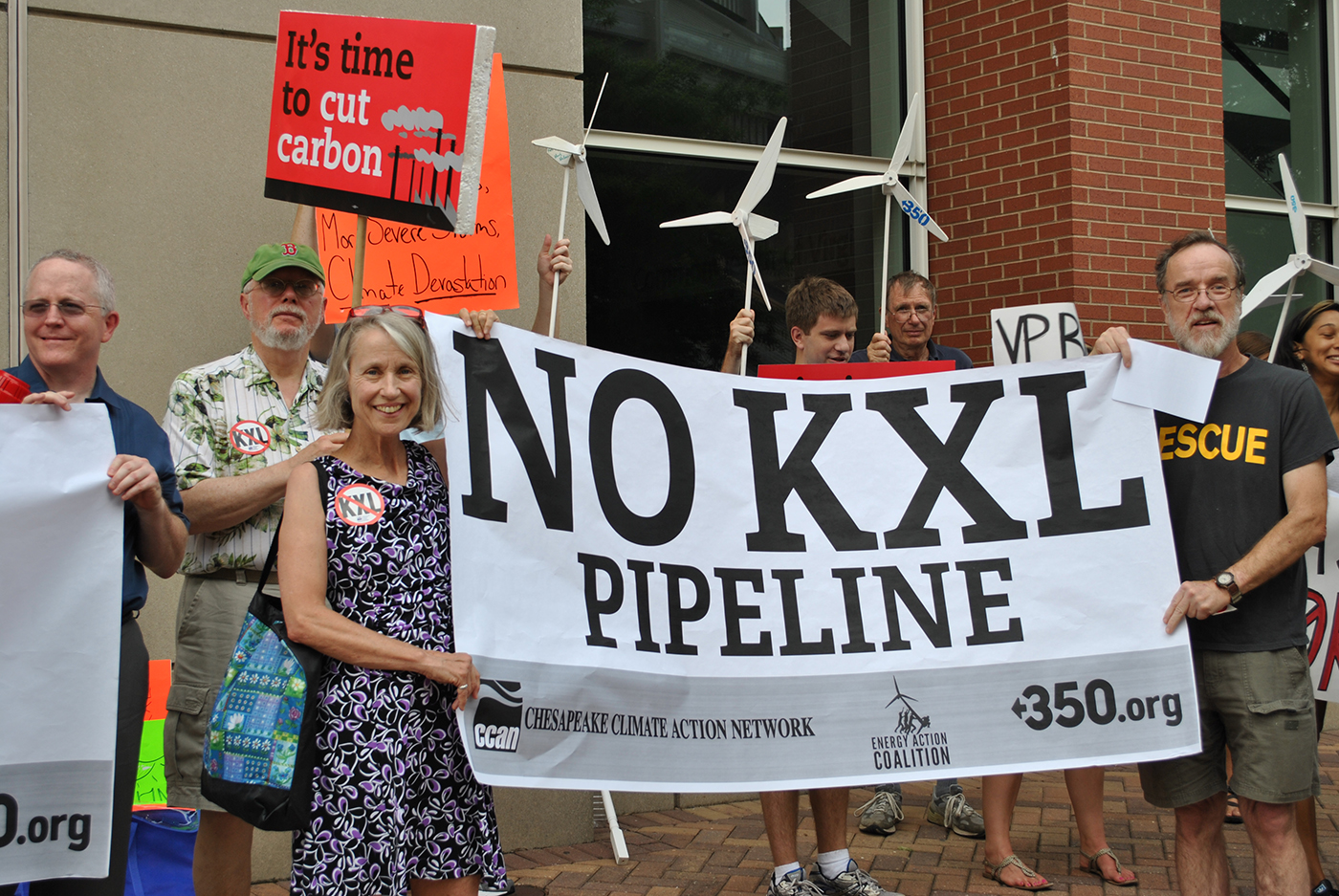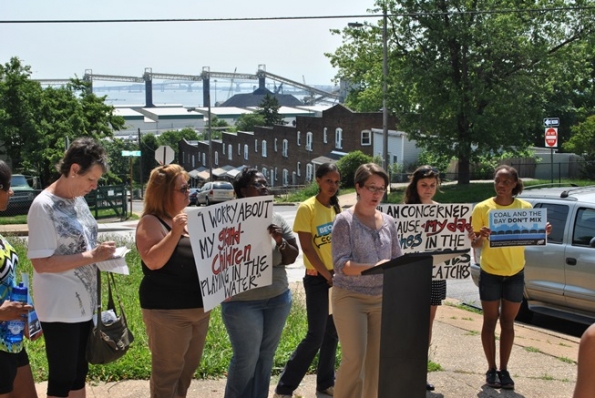|
June 2013 | Issue #65
Quick Links: DC & National | Maryland | Virginia | Students
FROM DIRECTOR MIKE TIDWELL
 Friends, Friends,
When CCAN was founded in 2002, the level of carbon dioxide in the atmosphere was 373 parts per million. Now, despite a growing clean-energy movement worldwide, scientists reported last month that the carbon level had reached a whole new stage of danger: 400 parts per million.
There hasn’t been this much heat-trapping CO2 in the Earth’s atmosphere in at least 3 million years. The result has been a marked increase in extreme and destructive weather. Listen to my NPR radio commentary concerning DC’s decision to spend $1 billion to put more power lines underground due to bigger storms. Imagine a world where we trap heat in the atmosphere equal to the energy of 400,000 Hiroshima bombs exploding every day. That’s what we are doing right now.
So despite the best efforts of CCAN and groups like us worldwide, we have much more work to do to fight dirty energy and promote clean power. In DC, here are two ways you can help right now…
See the full note from Mike>>

Camp David to DC: See you on the trail to stop Keystone XL?
From July 19th-July 27th, scores of activists will embark on a week-long walk from Camp David, MD to Washington, DC. Camp David was named after Dwight D. Eisenhower’s grandson, and the march will pressure President Obama to reject the Keystone XL pipeline in favor of bold climate solutions — for the future of all our children and grandchildren. At the same time, activists all across the country will hold creative actions — like raising a wind turbine directly in the path of Keystone XL — as part of the “Summer Heat” campaign. The temperatures will surely be rising in the dog days of July. But so will we. Will you join us on the trail? Learn more and sign up here.
DC needs wind and solar power not black liquor!
Would you rather support clean wind turbines or dirty black liquor with your DC electric bills? Once you learn what black liquor is — a paper mill waste byproduct that pollutes on par with coal — the choice is clear. This summer, CCAN organizing fellows will be educating District residents about the massive black liquor loophole in our city’s Renewable Porftolio Standard (RPS) law and building support for City Council action to close it. First, sign the petition yourself. Then, email DC Organizing Fellow Shelby Brown at shelbyb@chesapeakeclimate.org to learn how you can help gather petitions. Let’s ensure our clean energy dollars are spent on real clean energy!

Tell Governor O’Malley: Keep your promise to get the facts on fracking!
As we keep fighting for a legislative moratorium on fracking, we must also watchdog the fracking review process underway at state agencies. Under Governor O’Malley’s 2011 executive order on fracking, our state has only a year and some pocket change left to determine the full extent of the risks drilling poses to our water, air, and climate. The clock runs out in August 2014. Click here to tell Governor O’Malley: Keep your promises. Hold the line against dangerous drilling and ensure our state has the time and money needed to fully study fracking’s risks.
Want the full update on how Maryland state agencies are carrying out the Governor’s order? Check out Megan’s blog post.
Dirty coal’s new scheme to keep afloat and keep polluting
As the United States begins to move away from coal, coal executives are scrambling to keep their profits high by other means: exporting coal overseas. The stakes are high in our region. Existing coal ports in Baltimore and Norfolk saw record levels of exports in 2012. CCAN is working to block this surge of coal exports for two reasons: 1) We need to keep this pre-historic fuel in the ground to avoid climate disaster; and 2) More coal exports mean more pollution problems at home — from mountains destroyed in Appalachia to coal dust coating homes near railways to toxic pollution in waterways near ports.
We’re fighting back by challenging the export companies as they apply for pollution permits needed to expand their operations. We have our first opportunity to take action in Baltimore: Submit a public comment urging the Maryland Department of the Environment to strengthen water pollution controls at the CSX coal export piers on Baltimore’s Harbor.

Dominion’s new solar program — Is it for you?
Dominion’s new pilot solar purchase program has just opened for applications. Under the program, the company will buy solar power and the associated Renewable Energy Credits (RECs) from customers, then sells the RECs to other customers. Check out our blog post explaining — How does it work? Is it good for consumers? Should you participate?
Chasing Ice Coming to Virginia
This summer, we’re bringing Chasing Ice, arguably the most stunning climate change documentary of the last year, to Virginia. It follows the story of a photographer struggling to document the melting of glaciers before they’re all gone. After seeing the film in DC in the fall, CCAN Virginia State Director Beth Kemler told the rest of the team that she wanted to change her Thanksgiving “what I’m thankful for” answer to “the fact that I got to see beautiful glaciers on a trip to Patagonia a few years ago, since they may be gone soon.” Watch the incredible trailer here. Interested in helping to organize a screening in your area? Contact Keith Thirion at keitht@chesapeakeclimate.org or 703-579-6645.
Greet VP Biden with a big “No Keystone XL!” message
Vice President Joe Biden is headlining a gala dinner in Richmond on June 29th, and we’ll be there to show him why Virginians need the administration to reject the Keystone XL tar sands oil pipeline. What would the pipeline mean for the commonwealth? Rising seas flooding Norfolk, hotter temperatures threatening our health and agriculture, more severe storms wreaking havoc on our communities. We’ll be outside the Jefferson Jackson dinner to highlight these climate consequences, which will only be more severe if the pipeline is approved. We need a huge group to show just how strongly we oppose Keystone XL. Sign up to bring a big #noKXL message to Vice President Biden on June 29th!
Success! Climate wake-up call reaches Dominion shareholders
Virginia shareholder activists had a breakthrough at Dominion Resources’s annual meeting last month in Richmond: A resolution on climate change written by CCAN received a record level of support! InsideClimate News, which recently won a Pulitzer Prize for its investigation of a major tar sands oil spill, covered the vote. Read all about it here, including how Ruth McElroy Amundsen, a 51-year-old NASA engineer and mother of two, paved the way. Then, check out the recap on CCAN’s blog to see the “masterpieces” we displayed outside the meeting.

Ready…set…register for Power Shift 2013!
Power Shift 2013 registration is now open! What could be better than joining more than 10,000 young leaders in the forward-thinking city of Pittsburgh to hatch the plans that will win back our future? This incredible weekend of trainings, actions, inspiration and power-building will take place from October 18th-21st. In order to represent the Chesapeake region, we need to send hundreds of students from our area to Pittsburgh. Together, we’ll build our campaigns to divest from fossil fuels, fight fracking and win clean energy solutions to the climate crisis. Click here to register for Power Shift 2013. On Facebook, you can also join the official Power Shift 2013 event page and share this graphic to spread the word. Join the biggest youth climate convergence of our generation. Sign up before August 10th and pay less!

Meet Maryland community activist Ann Marie Nau
Ann is a resident of Myersville, a small community in Maryland fighting a huge natural gas compressor station that Dominion Transmission wants to build in the heart of their town. Fights like these are happening more and more across our region, as fracking increases the need for gas infrastructure like pipelines and compressor stations. Learn how Ann is pushing back with her neighbors and CCAN…
Your age: 46
Where you live: Myersville, MD
Your profession: Self-employed (transcriber) and stay-at-home Mom
Why are you a CCAN volunteer? I became aware of CCAN while researching organizations to help with our local fight against Dominion Transmission’s proposal to build a16,000 natural gas compressor station within the town limits of our rural community and have been inspired by CCAN’s mission, hard work and the dedication of their wonderful staff.
What has inspired you most working with CCAN? CCAN staff and volunteers are tireless! I have seen them in Western Maryland fighting fracking, in Annapolis working on various environmental and energy bills, in Frederick fighting the incinerator and compressor stations, in Baltimore hosting conferences, and throughout the state working on climate issues. They have marched on D.C. and are active in Virginia. Being a member of Myersville Citizens for a Rural Community and seeing first hand how hard it can be to build coalitions, I have always been impressed with CCAN’s willingness to work with other environmental groups.
What are the impacts of climate change and/or the fossil fuel industry that hit closest to home for you? As unconventional drilling expands, the infrastructure needed to support it also increases. My beautiful rural community nestled in the scenic Middletown Valley is being bull dozed by big business and the federal government via the Federal Energy Regulatory Commission (FERC) to place a huge natural gas compressor station in our town and within one mile of our elementary school. Despite the Town Council denying zoning approval, Dominion has been granted approval to proceed by FERC. If fracking proceeds in Western Maryland and if Dominion is granted the authority to export natural gas via the Cove Point facility, I am afraid Maryland will be faced with the same infrastructure development seen in Pennsylvania, which has turned much of the rural landscape into industrialized areas, polluting the land, water and air.
What do you hope to see happen to address climate change in the next year? On a local level, I am very concerned about the proposed Frederick incinerator and the prospect of fracking in Western Maryland as well as the proposed Cove Point Export Project.
What do you like to do when you’re not working on climate change? I enjoy bird watching, or nature watching in general. I’m a bit of a jack-of-all-trades (and master of none) so whatever project I currently have going, whether it be cupcake decorating for a party, sewing curtains, or working in my (mostly) native flower garden. I adore spending time with my nieces and nephews!
Who would you high five? I would most like to high five those people on the front lines who are negatively impacted by the coal and gas industry and who continue to fight, who continue to “speak truth to power,” and who refuse to be intimidated. It is their struggles that motivate me and remind me that I can no longer be silent.
|






















